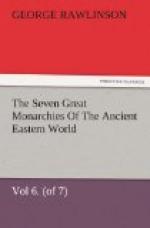It must have been soon after he received back his daughter that Chosroes died. His latest coins bear a date equivalent to A.D. 128; and the Roman historians give Volagases II. as king of Parthia in A.D. 133. It has been generally supposed that this prince was Chosroes’ son, and succeeded him in the natural course; but the evidence of the Parthian coins is strong against these suppositions. According to them, Volagases had been a pretender to the Parthian throne as early as A.D. 78, and had struck coins both in that year and the following one, about the date of the accession of Pacorus. His attempt had, however, at that time failed, and for forty-one years he kept his pretensions in abeyance; but about A.D. 119 or 120 he appears to have again come forward, and to have disputed the crown with Chosroes, or reigned contemporaneously with him over some portion of the Parthian kingdom, till about A.D. 130, when—probably on the death of Chosroes—he was acknowledged as sole king by the entire nation. Such is the evidence of the coins, which in this case are very peculiar, and bear the name of Volagases from first to last. It seems to follow from them that Chosroes was succeeded, not by a son, but by a rival, an old claimant of the crown, who cannot have been much younger than Chosroes himself.
CHAPTER XIX.
Reign of Volagases II. Invasion of the Alani. Communications between Volagases and Antoninus Pius. Death of Volagases II. and Accession of Volagases III. Aggressive War of Volagases III. on Rome. Campaign of A.D. 162. Verus sent to the East. Sequel of the War. Losses suffered by Parthia. Death of Volagases III.
Volagases II. appears to have occupied the Parthian throne, after the death of Chosroes, for the space of nineteen years. His reign has a general character of tranquillity, which agrees well with the advanced period of life at which, according to the coins, he first became actual king of Parthia. It was disturbed by only one actual outbreak of hostilities, an occasion upon which Volagases stood upon the defensive; and on one other occasion was for a brief period threatened with disturbance. Otherwise it seems to have been wholly peaceful. So far as appears, no pretenders troubled it. The coins show, for the years between A.D. 130 and A.D. 149, the head of but one monarch, a head of a marked type, which is impossible to be mistaken. [PLATE III., Fig. 4.]
The occasion upon which actual hostilities disturbed the repose of Volagases was in A.D. 133, when, by the intrigues of Pharasmanes, king of the Iberians, a great horde of Alani from the tract beyond the Caucasus was induced to pour itself through the passes of that mountain chain upon the territories of both the Parthians and the Romans Pharasmanes had previously shown contempt for the power of Rome by refusing to pay court to Hadrian, when, in A.D. 130, he invited the monarchs




